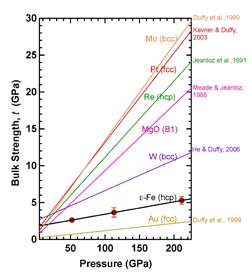Earth's core reveals an inner weakness

(Phys.org) —The word "core" conjures up an image of something strong. However, new experiments show that the iron found in the Earth's core is relatively weak. This finding is based on x-ray spectroscopy and diffraction measurements performed at high pressure and utilizing several x-ray beamlines at two U.S. Department of Energy Office of Science light sources including the Advanced Photon Source at Argonne National Laboratory. The researchers in these studies extrapolated their results to core conditions and found that the strength of iron deep within the Earth is lower than previously thought. This weakness may explain how the crystal structure in the Earth's core has transformed over geological time scales.
The extreme conditions of the Earth's core are very difficult to reproduce in a laboratory. The pressure rises above 3 million atmospheres (atm, 320-370 gigapascals, or GPa), and the temperature is comparable to that on the surface of the Sun (over 5000° C). Seismologists have learned about the core by studying seismic waves that travel through the Earth's interior.
One surprising discovery is that core-traversing seismic waves travel 3% faster along the polar axis as compared to those moving through the equatorial plane. Researchers assume that this seismic-wave anisotropy is due to iron crystals aligning their lattice structures. Such alignment requires a certain amount of "flow" through the solid core, and this has yet to be explained.
Deep inside the Earth, iron has a different structure than it does at the surface. For objects like horseshoes and tea kettles, the iron atoms are packed together in a pattern called body-centered cubic (bcc). However, when the pressure rises above 12 GPa, the iron atoms rearrange into a hexagonally close-packed (hcp) structure.
In order to better understand hcp iron, researchers from Stanford University and the SLAC National Accelerator Laboratory have made new strength measurements at high pressure, as described in Nature Geoscience. Strength, which is a material's resistance to flow, is characterized by the pressure at which the material begins to deform. Previous studies of iron's strength have typically applied pressure in a non-uniform (or non-hydrostatic) way.
To reproduce the hydrostatic conditions of the Earth's interior, the researchers here loaded their foil-shaped samples of iron into a gasket filled with a pressure-transmitting medium of neon or helium gas. This gasket was then placed in a diamond-anvil cell, where pressures as high as 200 GPa could be applied.
To study the material properties of hydrostatically compressed iron, the team first performed nuclear resonant inelastic x-ray scattering (NRIXS) experiments at two Advanced Photon Source x-ray beamlines: 3-ID-B (operated by the Argonne X-ray Science Division within the APS) and16-ID-D (operated by the High Pressure Collaborative Access Team, or HP-CAT). The spectrum of the scattered x-rays contained information about shear waves that travel through the iron like seismic waves. From their data analysis, the team derived the shear modulus—a measure of the rigidity of a material—and found it to be slightly lower than previous measurements of iron taken in non-hydrostatic environments.
The team then performed radial x-ray diffraction (rXRD) experiments at the HP-CAT 16-BM-D beamline, as well as with another x-ray beamline at the Advanced Light Source at Lawrence Berkeley National Laboratory. These measurements showed a shift in iron diffraction lines due to a squeezing (or strain) of the lattice separation when the sample was under pressure.
The researchers combined the observed strain and shear modulus values to obtain the strength of iron at high pressures. Surprisingly, the derived strength was 60% lower than previous estimates, making iron one of the weakest metals at high pressures (see the figure).
The team estimated that iron's strength is around 1 GPa at the pressure and temperature of the Earth's core. This low value has implications for how the material in the core deforms, or "creeps," over time. Previous models assumed that this creep was a very slow process, based mostly on diffusion of atoms. However, a lower strength for iron means that creep could occur through the movement of defects, or "dislocations," in the crystal structure. This faster dislocation creep would imply that the observed seismic-wave anisotropy developed relatively early in the Earth's history.
To explore this idea further, the team plans to perform a new set of iron experiments at high temperature as well as high pressure.
More information: "Strength of iron at core pressures and evidence for a weak Earth's inner core." A. E. Gleason & W. L. Mao. Nature Geoscience 6, 571–574 (2013) DOI: 10.1038/ngeo1808 . Received 05 October 2012 Accepted 28 March 2013 Published online 12 May 2013
Journal information: Nature Geoscience
Provided by US Department of Energy




















